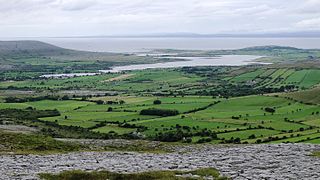
Inagh is a village and civil parish in County Clare, Ireland. It is situated 14 km west of Ennis on the Inagh River. It contains the villages of Inagh and Cloonanaha.

Kilfenora is a village and a civil parish in County Clare, Ireland. It is situated south of the karst limestone region known as the Burren. Since medieval times when it was the episcopal see of the Bishop of Kilfenora, it has been known as the "City of the Crosses" for its seven high crosses. The village had around 220 inhabitants in 2011. Much of the TV show Father Ted (1995–98) was filmed there.

Corofin is a town on the River Fergus in northern County Clare, Ireland and also a parish of the same name in the Catholic Diocese of Killaloe.
East Clare was a UK Parliament constituency in Ireland, returning one Member of Parliament (MP) from 1885 to 1922.

Clonderalaw is an historical barony in County Clare, Ireland. Baronies are geographical divisions of land that are in turn is divided into civil parishes.
Bunratty Upper is a barony in County Clare, Ireland. This ancient geographical division of land is in turn divided into six civil parishes.

Tulla Upper is a barony in County Clare, Ireland. This ancient geographical division of land is in turn divided into seven civil parishes.

Islands(Irish: Na hOileáin) is a barony located in County Clare, Ireland. This ancient unit of land division is in turn divided into five civil parishes.

Ibrickane is one of the ancient baronies of Ireland. It is a geographical division of County Clare. It is sub-divided into four civil parishes.
Inchiquin is a barony in County Clare, Ireland. This geographical unit of land is one of 11 baronies in the county. Its chief town is Corofin. It is administered by Clare County Council.

Rathborney, sometimes Rathbourney, is a civil parish in the Barony of Burren in County Clare, Ireland.

Oughtmama is a civil parish in County Clare. It lies in the Burren, a region in the northwest of the county. It contains many antiquities, including three early-medieval Christian churches, ruined castles, prehistoric cairns and ring forts and two Martello Towers built in the early 19th century.

Killilagh or Killeilagh is a civil parish in County Clare, Ireland. It contains the village of Doolin.

Noughaval or Nohoval is a civil parish in County Clare, Ireland.

Killonaghan or Killonahan is a civil parish in County Clare, Ireland. It covers a part of the Burren, a rugged area on the Atlantic coast, and contains the seaside village of Fanore.

Gleninagh or Glaninagh is a civil parish in County Clare, Ireland. It lies in the extreme northwest of the Burren, on the south of the mouth of Galway Bay. It is known for the well-preserved L-plan Gleninagh Castle, a 16th-century tower house. The parish also contains the lighthouse on Black Head.

Drumcreehy or Dromcreehy is a civil parish in County Clare, Ireland. It contains the village of Ballyvaughan.

Kilmanaheen is a civil parish in County Clare, Ireland. It contains the market town of Ennistymon.

Kilcorney is a civil parish in County Clare, Ireland. It lies in the Burren region of the northwest of the county.

New Quay or Newquay is a small coastal settlement in County Clare, Ireland. It takes its name from the quay built at this point on Galway Bay in the 19th century. New Quay is in the civil parish of Abbey and the historical barony of Burren. It is within the ecclesiastical parish of Carron & New Quay in the Roman Catholic Diocese of Galway, Kilmacduagh and Kilfenora. The former holiday home of Lady Gregory, Mount Vernon Lodge, is located in a neighbouring townland, also called New Quay. In the ITA Topographical and General Survey, published by the Irish Tourist Association in 1942, New Quay is described as "scarcely [..] a village as the houses are very scattered. However there is a Guards station, a P.O., and two shops". A pub and restaurant on the quayside, Linnane's Bar, is located in the former post office building.
















